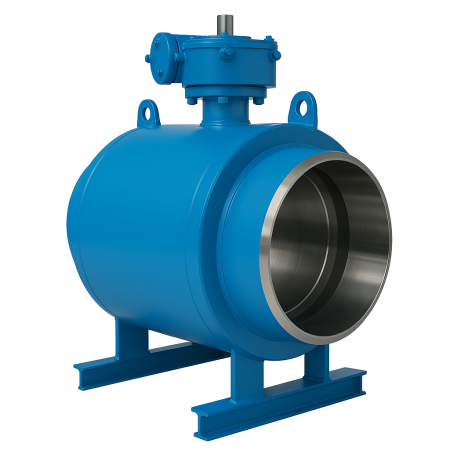Ball Valves haben eine Besonderheit, die ein Öffnen und Schließen mithilfe einer 90° Drehung zulassen. Der Kugelhahn ist mit einer durchbohrten Kugel versehen und bietet somit einen großen Vorteil gegenüber Gate Valves und Globe Valves.
Die wichtigsten Eigenschaften von Ball Valves
Ball Valves (Kugelhähne) ermöglichen eine zuverlässige, dichte Absperrung mit minimalem Strömungsverlust dank exakt angepasster Kugel und sind mit vollem oder reduziertem Durchgang sowie verschiedenen Antriebsarten verfügbar. Sie eignen sich durch ihre schnelle Schaltzeit, geringe Wartung und Varianten wie Spindelverlängerung für vielseitige Anwendungen in Industrie, Versorgung und Anlagenbau.
Präzise Durchflussregelung
Die in Ball Valves verwendeten Sitze aus Teflon, Neopren oder fluorierten Polymeren bieten ausgezeichnete Dichteigenschaften und ermöglichen zuverlässige Abdichtung bei niedrigen bis mittleren Temperaturen.
Temperaturbeständig
Ob extrem kalte oder heiße Prozesse – durch die Auswahl passender Dichtmaterialien wie Graphit oder Hochleistungskunststoffe sind Ball Valves für Temperaturen von -200 °C bis über 500 °C geeignet.
Geringes Drehmoment
Ball Valves sind kleiner als viele andere Ventiltypen, ermöglichen ein schnelles Öffnen und Schließen (90°-Drehung) und benötigen dabei nur ein geringes Drehmoment – ideal für automatisierte oder manuelle Anwendungen.
Häger Ball Valve nach ANSI Norm Ball Valve (Fully Welded)
Datenblätter
Größe: 2“ bis 60“
LBS: 150, 300, 600, 900, 1500
Gehäuse: A105N, LF2, F304, F316, F316ti, F316L, F321
Beschreibung zu unseren Ball Valves:
- Schweißenden nach ANSI B16.25
- Baulänge nach ANSI B16.10.
- Der Kugelhahn wird voll verscheißt hergestellt.
- Anti Static Device
- DOUBLE BLOCK & BLEED TYPE

- Voller Durchgang oder Reduzierter Durchgang / Full Bore & Red Bore
- Je nach Werkstoffwahl ist der Kugelhahn für Wasser, Dampf, Öl, GAS oder sonstige Medien geeignet.
- ISO – TOP Flansch (zum Aufbau eines Antriebes)
- Antrieb –> pneumatisch, elektrisch, hydraulisch, Gas über Öl oder per Getriebe & Handrad
- Isolieraufsatz / Spindelverlängerung / auch für Untergrund Installationen erhältlich
- FIRE SAFE API 6FA
- TA – LUFT nach VDI 2440
- Betriebs.-u. Wartungsanleitungen der Absperrschieber können in verschiedenen Landessprachen zur Verfügung gestellt werden.
- EAC TR –TS Konformitätsdeklarationen der Zollunion auftragsunabhängig für den Export und Einsatz der Produkte in der Russischen Föderation, Weißrussland oder Kasachstan (EAC), Gültigkeit 1, 3 oder 5 Jahre. EAC GOST TR TS 010/2011 (Machinery directive) oder EAC GOST TR TS 032/2013 für Armaturen größer und inkl. DN25
- Armaturenpass TP nach GOST 2.601 – 2006
Häger Ball Valve (2 – Piece)
Datenblätter
Größe: 1/2“ bis 26“
LBS: 150, 300, 400, 600
Gehäuse: 1.0619, A216 WCB, 1.4408, 1.4306, 1.4404, 1.1138, 1.4308, 1.5419, 1.7357, 1.7379, CF8M, CF3M, CF3, WC1 WC6, WC9, LCB, LCC
Beschreibung zu unseren Ball Valves:
- Mit schwimmender Kugel
- Baulänge nach ANSI B16.10
- Ausblassichere Spindel.
- Armaturen mit Konformitätserklärung und CE-Kennzeichnung nach DGRL97/23/EG
- Flanschausführung (ASME B16.5) & Schweißenden wählbar.

- Voller Durchgang oder Reduzierter Durchgang / Full Bore & Red Bore
- Je nach Werkstoffwahl ist der Kugelhahn für Wasser, Dampf, Öl, GAS oder sonstige Medien geeignet.
- ISO – TOP Flansch (zum Aufbau eines Antriebes)
- Antrieb –> pneumatisch, elektrisch, hydraulisch, Gas über Öl oder per Getriebe & Handrad
- Isolieraufsatz / Spindelverlängerung / auch für Untergrund Installationen erhältlich
- Sonderlackierung gemäß Kundenanforderung
- TA – LUFT nach VDI 2440
- Betriebs.-u. Wartungsanleitungen der Absperrschieber können in verschiedenen Landessprachen zur Verfügung gestellt werden.
- EAC TR –TS Konformitätsdeklarationen der Zollunion auftragsunabhängig für den Export und Einsatz der Produkte in der Russischen Föderation, Weißrussland oder Kasachstan (EAC), Gültigkeit 1, 3 oder 5 Jahre. EAC GOST TR TS 010/2011 (Machinery directive) oder EAC GOST TR TS 032/2013 für Armaturen größer und inkl. DN25
- Armaturenpass TP nach GOST 2.601 – 2006
Die wichtigsten Eigenschaften von Ball Valves
Unsere leistungsstarken Ball Valves sorgen für eine zuverlässige Absperrung mit minimalem Strömungsverlust, eignen sich für Wasser, Gas, Öl, Dampf und weitere Medien und bieten dank optionaler Antriebe und Spindelverlängerung maximale Flexibilität – ideal für industrielle Anwendungen mit hohen Anforderungen an Dichtheit, Temperatur- und Druckbeständigkeit.
Vorteile von Ball Valves
✓ Quick-Viertel-Ein-Aus-Betrieb
✓ Dichtschließend mit geringem Drehmoment
✓ Kleiner als die meisten anderen Ventile
Nachteile von Ball Valves
✓ Herkömmliche Kugelhähne haben schlechte Drosseleigenschaften
✓ Bei Aufschlämmungs- oder anderen Anwendungen können sich die suspendierten Partikel absetzen und in Körperhohlräumen eingeschlossen werden, was zu Verschleiß, Leckage oder Ventilversagen führt.
Trunnion Mounted Ball Valve
Ein Trunnion Mounted Ball Valve hat eine zusätzliche mechanische Verankerung oben und unten am Ball. Diese spezielle Montage ist für größere und höhere Ball Valves geeignet. Darüber hinaus ermöglicht diese Konstruktion eine Verringerung des Drehmoments, da der Ball an zwei Stellen gelagert ist. Jeder Kugelhahn ist schwenkbar gelagert. Der am Drehzapfen montierte Schaft absorbiert den Druck vom Leitungsdruck und verhindert so eine übermäßige Reibung zwischen der Kugel und den Sitzen, so dass das Betriebsdrehmoment auch bei vollem Arbeitsdruck niedrig bleibt.
Floating Ball Valve
Ein schwimmend gelagerter Ball Valve wird nicht von einem Zapfen gehalten und stattdessen nur am Schaft befestigt. Dies führt manchmal dazu, dass der Ball leicht stromabwärts schwimmt. Wenn dies jedoch geschieht, drückt der Ball gegen den Sitz und erzeugt eine positive Dichtung.
Full Bore
Full Bore Ball Valve oder auch als Full Port bekannt, hat einen Innendurchmesser der Bohrung, der ungefähr der der Rohrleitung entspricht. Dies ermöglicht verringerte Reibung und Druckverlust über das Ventil. Bei einem Full Bore Ball Valve gibt es keine Einschränkung für den Durchfluss des Fluids, ist dadurch auch teurer in der Anschaffung. Diese Art der Bohrung ist ideal für Situationen, in denen ein Molchen notwendig sein könnte. Diese Technologie wird häufig in der chemischen, petrochemischen und Raffinerie-Industrie verwendet.
Reduced Bore
Reduced Bore Ball Valves auch als Kugelhahn mit reduzierter Bohrung bekannt, ist ein Ventil, bei dem der Durchgang auf eine oder zwei Nennweiten reduziert ist. Dies sorgt für einen eingeschränkteren Strömungsweg, was im Allgemeinen zu höheren Energieverlusten führt.




